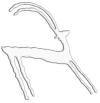Ērān ud Anērān
Webfestschrift Marshak 2003
[index]

Ērān ud Anērān |
Transoxiana
|
In Turkish Inscriptions of VIIIth century, such as Bilge Qaghan and Köl Tigin, a word "(A)Par" is mentioned (in BQ E 5, KT E 4), counting the whole representatives of important countries and nations participated in the mourning rites in Turkish headquarters in Mongolia because Bumïn Qaghan, the founder of the first Turkish Qaghanate had died in 553. This interesting word occurs while being counted the names of the nations or countries between Tüpüt (Tibet) and (A)Purum (Byzantium). In some researches we saw until now the name of Apar was explained either as the Avars (Juan-Juan or the European Avars?), or the whole Iran country, and even the "White Huns" (Ak-Huns) in northeastern Iran, from the point of views of some historical and also linguistic opinions, but without taking account of information out of some relating Armenian sources from Vth and VIIth centuries.
In this paper we are trying to examine this data in Turkish inscriptions together with that of Armenian sources.
In this connection we have some important and relating Armenian sources from Vth and VIIth centuries in which a word of "Apar Ապար" is mentioned. Our first source, Eghishe Vardapet was an eye-witness of the wars occured between the Sasanian Empire and some Armenian armies, especially those in 442-448 years. Giving information on the wars of Sasanians against Kushank, that is the Hephthalites, he mentioned a country in northeastern Iran as "Apar Ապար" which is possibly an equivalent for today Khorasan. Again, Ghazar Parpetsi who wrote his work named "History of Armenia" in 490-495 years, named a country as "Kushank country" or "Apar country". The solely source of VIIth century, Sebeos narrates the events between the Byzantine and Sasanian Empires, during the emperors Mauricius (582-602) and Khosrow II (590-628) respectively, and names Khosrow II as "Aparve:z", and a country in northeastern Iran, near the cities such as Nishapur and Tus as "Apar-shahr". And the last source, Ananias of Širak whose original and long version is accepted as written between 591 and 636 years, mentions the countries of Persia and Aria and their bounding parts, and names a part in the second country (Aria) as "Ap(a)r-Shahr", with Koshm and Wrkan.
There is also another opinion which suggests that this Apar might be concerning with a very old name, Apar-ni / Apar-na in the classical sources.
In this connection another problem is about whether the name of "Apar" is a geographical or political one.
In my opinion, the name "Apar" in Turkish Inscriptions of VIIIth century (Bilge Qaghan and Köl-Tigin) is not a geographical but a political one just as other some names seen in both Chinese and Turkish sources (Chi-pin, Kang-chü, Wu-i-shan-li, An-hsi etc., and Tabgach, (A)Purum / Byzance, Kyrkyz, Uch-Kurykan, Otuz Tatar etc.). But the name of "Apar" and the component of "Apar" in Armenian sources seems that it shows a geographical area (maybe Khorasan), relating to the possession there of maybe one political formation once. And this formerly possession might be the Hephthalites but not "White Huns" because these two dynasties were completely different from another, and the first replaced the second.
Actualizado el 24/07/2004